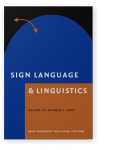Napoli, Donna Jo & Nathan Sanders
Pleyer, Michael, Ryan Lepic & Stefan Hartmann
2024.
Compositionality in Different Modalities: A View from Usage-Based Linguistics.
International Journal of Primatology 45:3
► pp. 670 ff.

Źywiczyński, Przemysław & Jordan Zlatev
2024.
The Role of Gesture in Debates on the Origins of Language. In
The Cambridge Handbook of Gesture Studies,
► pp. 335 ff.

Bradley, Chuck & Ronnie Wilbur
2023.
Visual Form and Event Semantics Predict Transitivity in Silent Gestures: Evidence for Compositionality.
Cognitive Science 47:8

Cohen-Koka, Shirit, Bracha Nir & Irit Meir
Moita, Mara, Ana Maria Abreu & Ana Mineiro
2023.
Iconicity in the emergence of a phonological system?.
Journal of Language Evolution 8:1
► pp. 1 ff.

Zwitserlood, Inge, Els van der Kooij & Onno Crasborn
Bradley, Chuck, Evie A. Malaia, Jeffrey Mark Siskind, Ronnie B. Wilbur & Marcus Perlman
2022.
Visual form of ASL verb signs predicts non-signer judgment of transitivity.
PLOS ONE 17:2
► pp. e0262098 ff.

Brentari, Diane, Rabia Ergin, Ann Senghas, Pyeong Whan Cho, Eli Owens & Marie Coppola
2021.
Community interactions and phonemic inventories in emerging sign languages.
Phonology 38:4
► pp. 571 ff.

Pouw, Wim, Mark Dingemanse, Yasamin Motamedi & Aslı Özyürek
2021.
A Systematic Investigation of Gesture Kinematics in Evolving Manual Languages in the Lab.
Cognitive Science 45:7

Tkachman, Oksana, Gracellia Purnomo & Bryan Gick
2021.
Repetition Preferences in Two-Handed Balanced Signs: Vestigial Locomotor Central Pattern Generators Shape Sign Language Phonetics and Phonology.
Frontiers in Communication 5

Żywiczyński, Przemysław, Sławomir Wacewicz & Casey Lister
2021.
Pantomimic fossils in modern human communication.
Philosophical Transactions of the Royal Society B: Biological Sciences 376:1824

ANIBLE, BENJAMIN
2020.
Iconicity in American Sign Language–English translation recognition.
Language and Cognition 12:1
► pp. 138 ff.

Börstell, Carl & Ryan Lepic
Donazzan, Marta & Luciana Sanchez-Mendes
2020.
Decomposing distribution across dimensions: evidence from Libras.
DELTA: Documentação de Estudos em Lingüística Teórica e Aplicada 36:1

Haluts, Neta, Massimiliano Trippa, Naama Friedmann & Alessandro Treves
2020.
Professional or Amateur? The Phonological Output Buffer as a Working Memory Operator.
Entropy 22:6
► pp. 662 ff.

MAKAROĞLU, Bahtiyar
2020.
Türk İşaret Dilinde Anlamsal Bağlantılığın ve Gösterimselliğin Sözlüksel Erişime Etkisi.
Hacettepe Üniversitesi Edebiyat Fakültesi Dergisi 37:2
► pp. 276 ff.

OCCHINO, CORRINE, BENJAMIN ANIBLE & JILL P. MORFORD
2020.
The role of iconicity, construal, and proficiency in the online processing of handshape.
Language and Cognition 12:1
► pp. 114 ff.

Brentari, Diane
2019.
Sign Language Phonology,

Krebs, Julia, Ronnie B. Wilbur, Phillip M. Alday & Dietmar Roehm
2019.
The Impact of Transitional Movements and Non-Manual Markings on the Disambiguation of Locally Ambiguous Argument Structures in Austrian Sign Language (ÖGS).
Language and Speech 62:4
► pp. 652 ff.

Kuhn, Jeremy
2019.
Pluractionality and distributive numerals.
Language and Linguistics Compass 13:2

Napoli, Donna Jo & Stephanie Liapis
2019.
Effort reduction in articulation in sign languages and dance.
Journal of Cultural Cognitive Science 3:1
► pp. 31 ff.

SEVCIKOVA SEHYR, ZED & KAREN EMMOREY
2019.
The perceived mapping between form and meaning in American Sign Language depends on linguistic knowledge and task: evidence from iconicity and transparency judgments.
Language and Cognition 11:2
► pp. 208 ff.

Żywiczyński, Przemysław
2019.
How research on language evolution contributes to linguistics.
Yearbook of the Poznan Linguistic Meeting 5:1
► pp. 1 ff.

Lepic, Ryan & Corrine Occhino
2018.
A Construction Morphology Approach to Sign Language Analysis. In
The Construction of Words [
Studies in Morphology, 4],
► pp. 141 ff.

Meir, Irit & Ariel Cohen
2018.
Metaphor in Sign Languages.
Frontiers in Psychology 9

Perlman, Marcus, Hannah Little, Bill Thompson & Robin L. Thompson
2018.
Iconicity in Signed and Spoken Vocabulary: A Comparison Between American Sign Language, British Sign Language, English, and Spanish.
Frontiers in Psychology 9

Östling, Robert, Carl Börstell & Servane Courtaux
2018.
Visual Iconicity Across Sign Languages: Large-Scale Automated Video Analysis of Iconic Articulators and Locations.
Frontiers in Psychology 9

HWANG, SO-ONE, NOZOMI TOMITA, HOPE MORGAN, RABIA ERGIN, DENIZ İLKBAŞARAN, SHARON SEEGERS, RYAN LEPIC & CAROL PADDEN
2017.
Of the body and the hands: patterned iconicity for semantic categories.
Language and Cognition 9:4
► pp. 573 ff.

Sandler, Wendy
2017.
The Challenge of Sign Language Phonology.
Annual Review of Linguistics 3:1
► pp. 43 ff.

Sandler, Wendy
2018.
The Body as Evidence for the Nature of Language.
Frontiers in Psychology 9

Sandler, Wendy
2022.
Redefining Multimodality.
Frontiers in Communication 6

Sandler, Wendy
2024.
Speech and sign: the whole human language.
Theoretical Linguistics 50:1-2
► pp. 107 ff.

Sandler, Wendy & Diane Lillo‐Martin
2017.
Sign Languages. In
The Handbook of Linguistics,
► pp. 371 ff.

Börstell, Carl, Ryan Lepic & Gal Belsitzman
This list is based on CrossRef data as of 19 july 2024. Please note that it may not be complete. Sources presented here have been supplied by the respective publishers.
Any errors therein should be reported to them.
